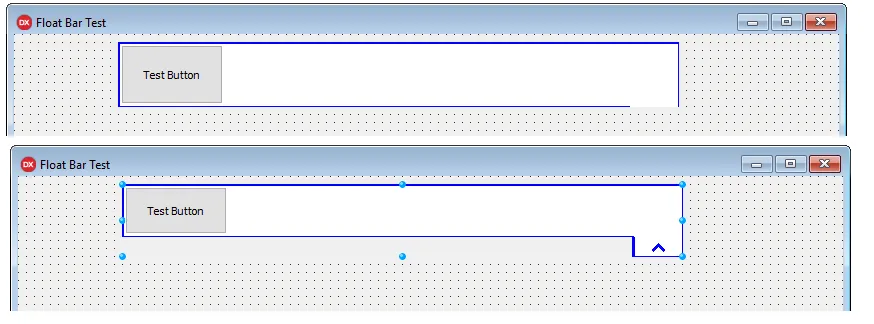我正在编写一个自定义控件,它只是一个带有非客户区的容器。在那个非客户区内,有一个小区域是按钮,其余部分是透明的。绘图不是一个精确的矩形。
到目前为止,我已经完成了一半。问题是,除非我进行微小的调整,例如重新调整大小,否则它不会预先计算非客户区域。
我遵循了许多描述如何完成此操作的资源。我的处理WM_NCCALCSIZE的实现与我找到的“工作”的示例或多或少相同。但是当控件首次创建时,它根本不计算这个。当我在我的消息处理程序(WMNCCalcSize)中放置断点时,根据我找到的示例,我应该首先检查Msg.CalcValidRects,仅在其为True时执行计算。但是在运行时调试时,它是False,因此未执行计算。
在设计时,如果我重新调整控件大小,那么它才会正确计算。虽然还不完美(这段代码还在修改中),但似乎直到我微调它之后才设置非客户区域。此外,在运行时,如果我在代码中微调大小,它仍然不会计算。 顶部的图像是表单最初创建/显示时的情况。第二个图像是我稍微调整大小后的情况。请注意测试按钮,它对齐方式为
如果我注释掉检查
我做错了什么,如何使其始终计算非客户端区域?
到目前为止,我已经完成了一半。问题是,除非我进行微小的调整,例如重新调整大小,否则它不会预先计算非客户区域。
我遵循了许多描述如何完成此操作的资源。我的处理WM_NCCALCSIZE的实现与我找到的“工作”的示例或多或少相同。但是当控件首次创建时,它根本不计算这个。当我在我的消息处理程序(WMNCCalcSize)中放置断点时,根据我找到的示例,我应该首先检查Msg.CalcValidRects,仅在其为True时执行计算。但是在运行时调试时,它是False,因此未执行计算。
在设计时,如果我重新调整控件大小,那么它才会正确计算。虽然还不完美(这段代码还在修改中),但似乎直到我微调它之后才设置非客户区域。此外,在运行时,如果我在代码中微调大小,它仍然不会计算。 顶部的图像是表单最初创建/显示时的情况。第二个图像是我稍微调整大小后的情况。请注意测试按钮,它对齐方式为
alLeft。因此,最初它占用了应该是非客户端区域的区域。如果我注释掉检查
if Msg.CalcValidRects then begin,那么它会正确计算。但我看到每个示例都进行了这个检查,我很确定它是必需的。我做错了什么,如何使其始终计算非客户端区域?
unit FloatBar;
interface
uses
System.Classes, System.SysUtils, System.Types,
Vcl.Controls, Vcl.Graphics, Vcl.Forms,
Winapi.Windows, Winapi.Messages;
type
TFloatBar = class(TCustomControl)
private
FCollapsed: Boolean;
FBtnHeight: Integer;
FBtnWidth: Integer;
procedure RepaintBorder;
procedure PaintBorder;
procedure SetCollapsed(const Value: Boolean);
function BtnRect: TRect;
procedure SetBtnHeight(const Value: Integer);
procedure SetBtnWidth(const Value: Integer);
function TransRect: TRect;
protected
procedure CreateParams(var Params: TCreateParams); override;
procedure WMEraseBkgnd(var Message: TWMEraseBkgnd); message WM_ERASEBKGND;
procedure WMNCPaint(var Message: TWMNCPaint); message WM_NCPAINT;
procedure WMNCHitTest(var Message: TWMNCHitTest); message WM_NCHITTEST;
procedure WMNCCalcSize(var Msg: TWMNCCalcSize); message WM_NCCALCSIZE;
procedure Paint; override;
public
constructor Create(AOwner: TComponent); override;
destructor Destroy; override;
procedure Repaint; override;
procedure Invalidate; override;
published
property BtnWidth: Integer read FBtnWidth write SetBtnWidth;
property BtnHeight: Integer read FBtnHeight write SetBtnHeight;
property Collapsed: Boolean read FCollapsed write SetCollapsed;
end;
procedure Register;
implementation
procedure Register;
begin
RegisterComponents('Float Bar', [TFloatBar]);
end;
{ TFloatBar }
constructor TFloatBar.Create(AOwner: TComponent);
begin
inherited;
ControlStyle:= [csAcceptsControls,
csCaptureMouse,
csDesignInteractive,
csClickEvents,
csReplicatable,
csNoStdEvents
];
Width:= 400;
Height:= 60;
FBtnWidth:= 50;
FBtnHeight:= 20;
FCollapsed:= False;
end;
procedure TFloatBar.CreateParams(var Params: TCreateParams);
begin
inherited CreateParams(Params);
with Params.WindowClass do
Style := Style and not (CS_HREDRAW or CS_VREDRAW);
end;
destructor TFloatBar.Destroy;
begin
inherited;
end;
procedure TFloatBar.Invalidate;
begin
inherited;
RepaintBorder;
end;
procedure TFloatBar.Repaint;
begin
inherited Repaint;
RepaintBorder;
end;
procedure TFloatBar.RepaintBorder;
begin
if Visible and HandleAllocated then
Perform(WM_NCPAINT, 0, 0);
end;
procedure TFloatBar.SetBtnHeight(const Value: Integer);
begin
FBtnHeight := Value;
Invalidate;
end;
procedure TFloatBar.SetBtnWidth(const Value: Integer);
begin
FBtnWidth := Value;
Invalidate;
end;
procedure TFloatBar.SetCollapsed(const Value: Boolean);
begin
FCollapsed := Value;
Invalidate;
end;
procedure TFloatBar.WMNCPaint(var Message: TWMNCPaint);
begin
inherited;
PaintBorder;
end;
procedure TFloatBar.WMEraseBkgnd(var Message: TWMEraseBkgnd);
begin
Message.Result := 1;
end;
procedure TFloatBar.WMNCCalcSize(var Msg: TWMNCCalcSize);
var
lpncsp: PNCCalcSizeParams;
begin
if Msg.CalcValidRects then begin //<------ HERE --------
lpncsp := Msg.CalcSize_Params;
if lpncsp = nil then Exit;
lpncsp.rgrc[0].Bottom:= lpncsp.rgrc[0].Bottom-FBtnHeight;
Msg.Result := 0;
end;
inherited;
end;
function TFloatBar.BtnRect: TRect;
begin
//Return a rect where the non-client collapse button is to be...
Result:= Rect(ClientWidth-FBtnWidth, ClientHeight, ClientWidth, ClientHeight+FBtnHeight);
end;
function TFloatBar.TransRect: TRect;
begin
//Return a rect where the non-client transparent area is to be...
Result:= Rect(0, ClientHeight, ClientWidth, ClientHeight+FBtnHeight);
end;
procedure TFloatBar.WMNCHitTest(var Message: TWMNCHitTest);
var
P: TPoint;
C: TCursor;
begin
C:= crDefault; //TODO: Find a way to change cursor elsewhere...
P:= Point(Message.XPos, Message.YPos);
if PtInRect(BtnRect, P) then begin
Message.Result:= HTCLIENT;
C:= crHandPoint;
end else
if PtInRect(TransRect, P) then
Message.Result:= HTTRANSPARENT
else
inherited;
Screen.Cursor:= C;
end;
procedure TFloatBar.Paint;
begin
inherited;
//Paint Background
Canvas.Brush.Style:= bsSolid;
Canvas.Pen.Style:= psClear;
Canvas.Brush.Color:= Color;
Canvas.FillRect(Canvas.ClipRect);
Canvas.Pen.Style:= psSolid;
Canvas.Pen.Width:= 3;
Canvas.Brush.Style:= bsClear;
Canvas.Pen.Color:= clBlue;
Canvas.MoveTo(0, 0);
Canvas.LineTo(ClientWidth, 0); //Top
Canvas.LineTo(ClientWidth, ClientHeight+FBtnHeight); //Right
Canvas.LineTo(ClientWidth-FBtnWidth, ClientHeight+FBtnHeight); //Bottom of Button
Canvas.LineTo(ClientWidth-FBtnWidth, ClientHeight); //Left of Button
Canvas.LineTo(0, ClientHeight); //Bottom
Canvas.LineTo(0, 0);
end;
procedure TFloatBar.PaintBorder;
begin
Canvas.Handle:= GetWindowDC(Handle);
try
//TODO: Paint "transparent" area by painting parent...
//Paint NC button background
Canvas.Brush.Style:= bsSolid;
Canvas.Pen.Style:= psClear;
Canvas.Brush.Color:= Color;
Canvas.Rectangle(ClientWidth-FBtnWidth, ClientHeight, ClientWidth, ClientHeight+FBtnHeight);
//Paint NC button border
Canvas.Pen.Style:= psSolid;
Canvas.Pen.Width:= 3;
Canvas.Brush.Style:= bsClear;
Canvas.Pen.Color:= clBlue;
Canvas.MoveTo(ClientWidth, ClientHeight);
Canvas.LineTo(ClientWidth, ClientHeight+FBtnHeight);
Canvas.LineTo(ClientWidth-FBtnWidth, ClientHeight+FBtnHeight);
Canvas.LineTo(ClientWidth-FBtnWidth, ClientHeight);
//Paint NC Button Chevron //TODO: Calculate chevron size/position
if FCollapsed then begin
Canvas.MoveTo(ClientWidth-30, ClientHeight+7);
Canvas.LineTo(ClientWidth-25, ClientHeight+13);
Canvas.LineTo(ClientWidth-20, ClientHeight+7);
end else begin
Canvas.MoveTo(ClientWidth-30, ClientHeight+13);
Canvas.LineTo(ClientWidth-25, ClientHeight+7);
Canvas.LineTo(ClientWidth-20, ClientHeight+13);
end;
finally
ReleaseDC(Handle, Canvas.Handle);
end;
end;
end.
